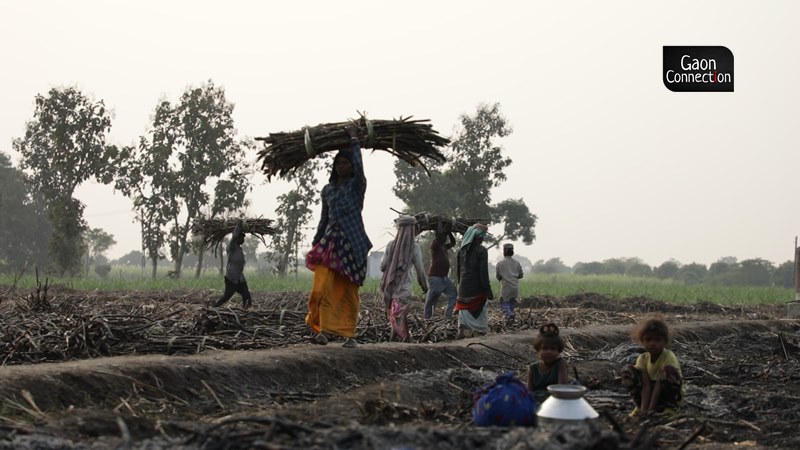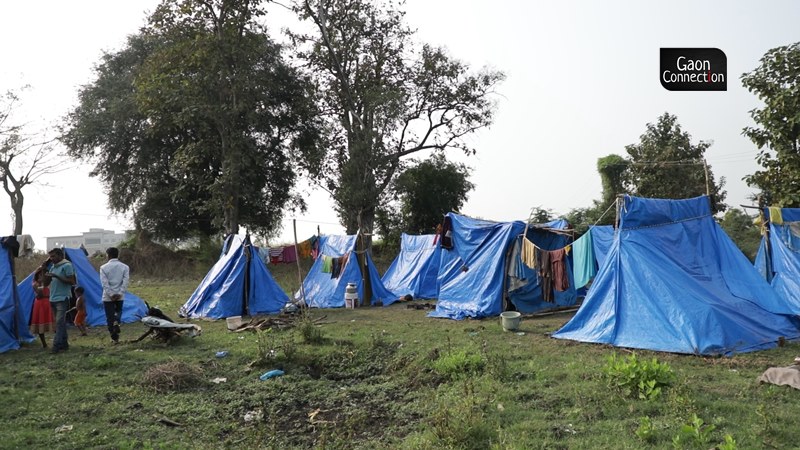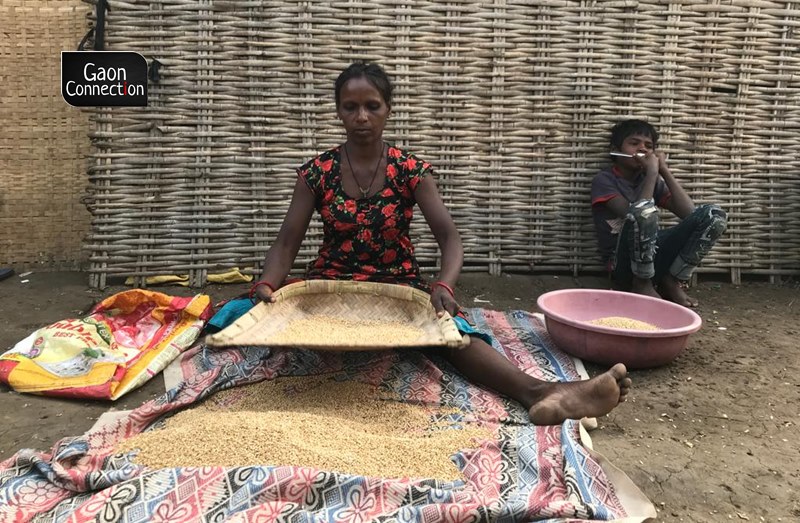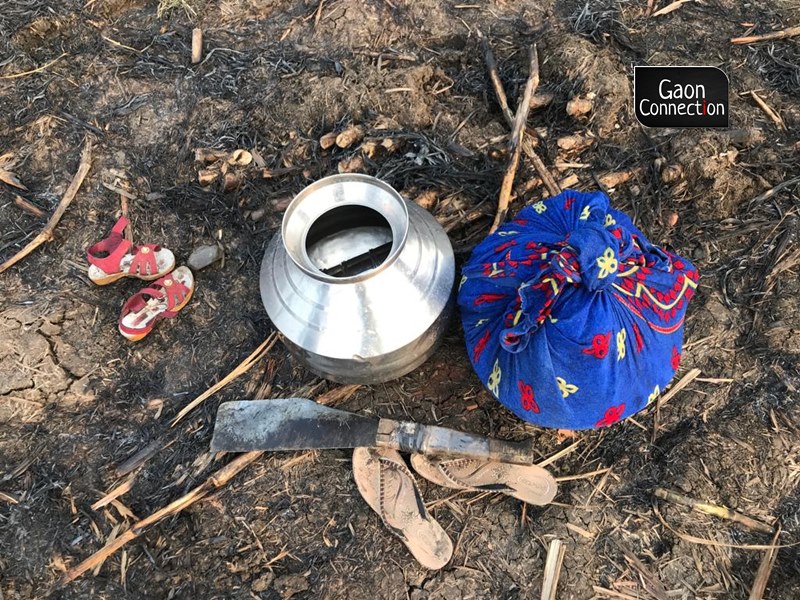The Cane Cutters of Gujarat: They work 12 hours a day and get paid after six months
Tribal migrant labourers in South Gujarat, slog long hours on sugarcane farms, but have neither proper homes, toilets nor education for their children. Their wages are handed to them only at the end of six months, which leads them right into the dedhi debt trap that thrives on the hefty 50 per cent interest.

Bajipura (Valsad) and Ahwa (Dang), Gujarat
Careful not to disturb any lurking snakes, Moti Singh, his bhira (wife) Rekha, and their four children make their way across fields and shrubland before daybreak. They walk five kilometres to the vast sugarcane field at the outskirts of Bajipura village, where they work. This is their routine for at least six months in a year.
Once they reach, they leave their children under the open sky in one corner of the sugarcane field, Moti and Rekha spend the next ten to twelve hours squatting in the field, cutting the sharp cane that leaves their hands and feet bruised and with splinters.
“Koi samay ka thikana nahi [We have no fixed work hours]; we work day and night. Sometimes the truck comes at midnight, and we have to wait to load the sugarcane,” said Moti, who hails from Mogara village in Ahwa taluka of Dang, but now lives in Bajipura on account of work. “Kyunki pet jo sambhalna hai [have to feed the stomach],” he told Gaon Connection.
Every year, between November and May, tribal families from the tribal district of Dang, migrate to the neighbouring districts of Surat, Navsari and Valsad in south Gujarat to work as cane cutters in the sugarcane farms.

For generations these adivasis have remained exploited, overworked and underpaid as they have worked as koytas (a term used for a husband-and-wife couple who cut cane). That is their only identity, no one cares to know their real names.
“We work day and night for six months and only then do we receive our payment based on how much cane we have cut that season. We don’t get daily wages or a monthly salary,” 36-year-old Jimmanbhai Chandra Pawar, a native of Ahwa in Dang, told Gaon Connection.
“We are paid before we head back home post harvest after our debts are deducted,” Moti said.
Most adivasi cane cutters are forced to borrow money to make ends meet. They get trapped in the dedhi system in which they are loaned money at a hefty interest rate of 50 per cent (dedh in Hindi means one and a half).
“These labourers borrow money from the mukadam or the middleman, who hires them for sugarcane cutting. The interest rate is 50 per cent and it is very difficult for these labourers to ever pay back the full amount,” Jayeshbhai of the Mazdoor Sangh Subri in Dang, told Gaon Connection.
“Technically, while these adivasi cane cutters aren’t bonded labourers, they are caught in a vicious circle that forces them and their children to work as cane cutters under highly exploitative conditions. There is no escape,” the activist added.

The adivasi cane cutters of south Gujarat
Dang is a tribal district predominantly inhabited by the Konkana, Bhil, Varli, Kotwalia, Kathodi and Gamit tribes, which constitute nearly 94.6 per cent of the total population. The district fares abysmally low in several social and health indicators.
Almost 86 per cent of its total families fall under the BPL (below poverty line) category, and majority of the population practises rainfed agriculture and seasonally migrates in search of livelihood, notes a study Endangered Livelihoods: Adivasi Seasonal Labour Migration in the Dangs of Gujarat.
“Poverty, debt, poor return from agriculture and lack of local employment opportunities are the major reasons for seasonal labour migration of the tribal households in The Dangs,” reads the 2013 study.
Also Read: If children could vote: In poll-bound UP, high malnourishment but 66% POSHAN funds unutilised
According to the Gujarat State Federation of Cooperative Sugar Factories Limited (GSFCSFL), there are 24 sugar mills in the state out of which 16 are located in south Gujarat (Dang, Valsad, Navsari, Tapi, Surat, Narmada and Bharuch districts). About 450,000 farmer families cultivate sugarcane on 162,000 hectares within the purview of GSFCSFL’s sugar factories.
A December 2017 study, A Bitter Harvest: A study of migrant sugarcane harvesting workers of south Gujarat, has documented how 150,000 to 200,000 migrant harvesters are involved in sugarcane cutting in the region.
The December 2017 research, based on the field study, found 80 per cent of the harvesters in the age group of 21 to 45 years, and 80 per cent of them were illiterate. Three-fourth of the tribal harvesters belonged to landless families whereas another 20 per cent owned small and marginal land-holdings.
“South Gujarat has 12 sugar mills and our studies show that up to two lakh tribal migrant workers come to harvest cane from as far as Maharashtra and Madhya Pradesh,” said Jayeshbhai. “Every district has a mukadam who has a tie up with the sugar factories and brings labour for these factories every year,” he added.
“I have been coming here with my husband to cut sugarcane for the past 15 years. My four kids also come with me and we live in these huts for six months,” Bhartiben, a native of Mogara village in Dang, who had come to Bajipura to cut cane, told Gaon Connection.
“Life of the women cane cutters is the worst. We work all day in the fields, and then return home and cook with the meagre food supplies we have,” said the mother of four. “Khana kamm hi padta hai roz. Bacche bookhe rah jaye [Food always falls short and the kids often go hungry],” she added.
Extremely exploitative work conditions
Heena is 15 years old. While cutting cane at a farm at the outskirts of Bajipura village in Vapi, she told Gaon Connection that she has been seasonally migrating to work as a cane cutter for nearly five years. “I did study till class 5 but dropped out as I prefer coming here and earning money for the family,” she smiled shyly.
Moti Singh too was only 14 years old when he began accompanying his father to the sugarcane fields. Now, at 24, he continues the backbreaking job.
Mukadams claim they are helpless too, as they are dependent on cane cutting activities to make a living. “I have been coming here along with the labour for the past six to seven years. We begin work at 5:30 in the morning and work till seven or eight in the evening. If the truck comes at night, we have to rush back to load it. Sometimes we do not even get time to eat our dinner,” Sampatbhai Ramji bhai Suryavanshi, a tribal mukadam who hails from Borakhadi village in Dang, told Gaon Connection.
Also Read: The tihaiya farmers of Vindhya region caught in a cycle of debt and destitution
“If the truck comes at eight in the evening, we have to stay back and load the truck. Our kids also wait with us in the fields and often sleep there and then we carry them home in the dead of the night,” the mukadam, who had brought 40 tribal labourers from Dang, added.

No basic infrastructure has been created for these migrant workers. When Gaon Connection visited their makeshift colony at the outskirts of Bajipura village, there was filth everywhere. The dilapidated huts of these labourers were made of bamboo and blue plastic sheets. There were stagnant pools of water everywhere. There were no toilets, and only two water taps were available for about 700-800 migrant labourers.
“There are no fixed timings for water. I have to make several trips, walking one kilometre each time to fetch water,” said Bharti ben. “Since water supply is unreliable, we store enough water for two days,” she added.
No wages for six months
“The koytas work in a tukdi (group) that is registered under the name of mukadam. The daily cane harvesting data of the tukdi is maintained by the mukadam,” explained Jayeshbhai of the Mazdoor Sangh Subri.
“At the end of the season, that is six months, depending on the sugarcane harvested, the money is equally distributed among the koytas of the tukdi,” he explained.
According to mukadam Sampatbhai, “for one tonne of cane harvested, the koyta (two members) earns Rs 280. The mukadam gets a commission of fifty five rupees per ton.”
Sugar factories offer these families some jowar or bajra (millets) for them to cook and eat, but they have to pay for it. “However, the payment for this jowar and bajra is deducted from their final payment,” said Sampatbhai.
“They are however allowed to take the top leafy portion of the cane, which they then sell to the local villagers as fodder. Seven to eight kandi [bundles] of this green fodder earns them one rupee,” he added.
“Do you think we can survive on the jowar given by the factory? It is in limited quantity [30 kilos a month] and of poor quality. We need to buy rice, oil, pulses, etc,” said a woman koyta while her child nibbled at a dry jowar roti with salt.
“These workers are also given hundred rupees a day as kharchi to buy food grains, etc. But, even that money is deducted from their payments,” said Jayeshbhai. “Thus, at the end of the six months, the koyta barely earns a few thousand and continues to be trapped in the vicious circle,” he lamented.
Just before the monsoon, these tribal migrant workers return to their native villages and spend the next couple of months there. “I have land but it is no good as there is no irrigation facility. We are completely dependent on the rains for farming so during the monsoon season, we grow some food and survive,” said Jimmanbhai.

Dedhi system
“Last year, I took a loan of twenty thousand on the dedhi system. So I now need to return thirty thousand. In six months, my bhira and I together earn about forty to forty-five thousand. After repaying the loan and the interest amount, we barely get fifteen or twenty thousand rupees in hand,” said Moti.
“We don’t get loan from anywhere else, no bank trusts us. We take money only from the mukadam,” he added. Moti still has an unpaid loan of Rs 45,000.
Mukadams, who offer loan at 50 per cent interest rate, are also caught in debt as they borrow money from private money lenders to lend it to their labourers.
Also Read: One in five rural households sold or mortgaged land, jewellery or valuables during the lockdown
“I have a Rs 1.5 lakh loan on my head and will have to pay Rs 2.25 lakh. I also borrow money under the dedhi system. Labourers need money for treating illnesses, marriage in the family, etc. And since they are attached to me, I get them the money at the earliest,” said mukadam Sampatbhai.
“If labourers do not repay the loan, I also remain under debt. Sometimes, the labourers run away. If the interest rate is reduced, it will help the mazdoor,” he added.

Bereft of government welfare schemes
The children of the tribal migrant families are deprived of education most of the time, nor can they avail of the ICDS (Integrated Child Development Services) schemes.
Also Read: If children could vote: In poll-bound UP, high malnourishment but 66% POSHAN funds unutilised
“My kids drop out of school when we migrate for six months. They do not get ration from the anganwadis or the meals at school (mid-day meals). But what option do I have? Where do I leave my kids,” asked Bharti.
“Children do not get ration from anganwadi for six months. We eat rice — we have to buy it on our own. We live in a jhopada here,” said Jimmanbhai, a father of four.
“We are helpless. We have to raise our kids. But we have nothing back home and are forced to come here and work as koyta. If the government cares, it should come forward and help us. At least our payment should increase. Chaubees kalak kaam karte hain hum [we work 24 hours a day],” Moti pleaded.
Also Read: UP’s villages might vote again on caste and religion. But what they desperately want: clean water.
According to a district official at Dang, there were several schemes for the benefit of the tribal families. However, these people were habituated to migrating and working as cane cutters, he said.
However, the December 2017 study, A Bitter Harvest, conducted by Prayas Centre for Labour Research and Action notes: “The harvesters are trapped in a vortex of poverty and unemployment at their native places and hence, have become easy prey to inhuman exploitation in harvesting operations.”
“Implementation of MGNREGA, improving agriculture based livelihoods, skill development of youths and artisans and protecting rights of the migrant labourers are the core areas where interventions need to be done which would eventually provide sustainable livelihoods to the tribals of The Dangs,” recommends another field-based study (2013).

